Formatting a Research Paper
Learning Objectives
- Identify the major components of a research paper written using American Psychological Association (APA) style.
- Apply general APA style and formatting conventions in a research paper.
Here you will learn how to use APA style, the documentation and formatting style followed by the American Psychological Association.
General Formatting Guidelines
This chapter provides detailed guidelines for using the citation and formatting conventions developed by the American Psychological Association, or APA. Writers in disciplines as diverse as astrophysics, biology, psychology, and education follow APA style. The major components of a paper written in APA style are listed in the following box.
These are the major components of an APA-style paper:
- Title page
- Abstract
Body, which includes the following:
- Headings and, if necessary, subheadings to organize the content
- In-text citations of research sources
- References page
All these components must be saved in one document, not as separate documents.
Title Page
The title page of your paper includes the following information:
- Title of the paper
- Author’s name
- Name of the institution with which the author is affiliated
- Header at the top of the page with the paper title (in capital letters) and the page number (If the title is lengthy, you may use a shortened form of it in the header.)
List the first three elements in the order given in the previous list, centered about one third of the way down from the top of the page. Use the headers and footers tool of your word-processing program to add the header, with the title text at the left and the page number in the upper-right corner. Your title page should look like the following example.

Abstract
The next page of your paper provides an abstract, or brief summary of your findings. An abstract does not need to be provided in every paper, but an abstract should be used in papers that include a hypothesis. A good abstract is concise—about one hundred fifty to two hundred fifty words—and is written in an objective, impersonal style. Your writing voice will not be as apparent here as in the body of your paper.
When writing the abstract, take a just-the-facts approach, and summarize your research question and your findings in a few sentences.
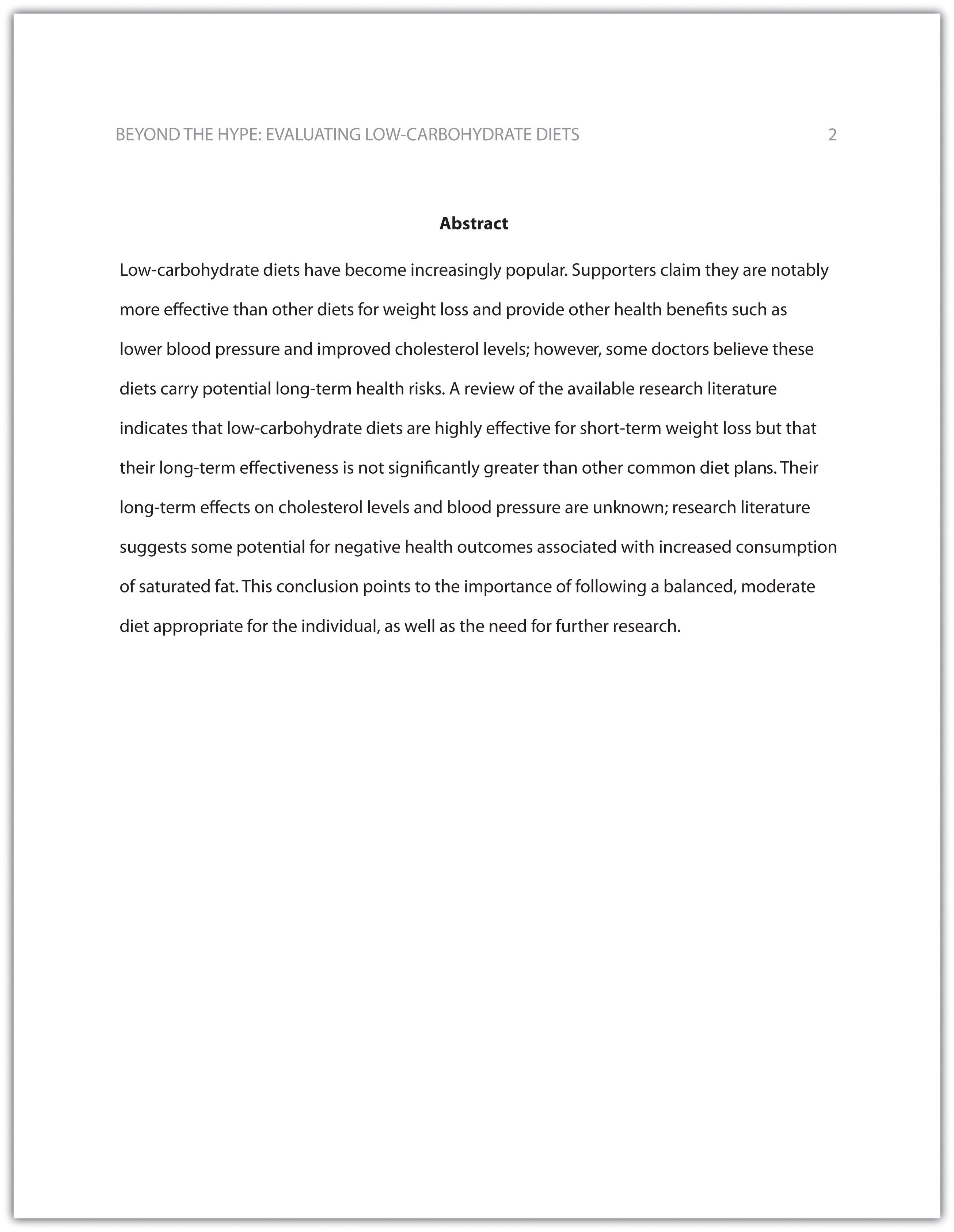
Margins, Pagination, and Headings
APA style requirements also address specific formatting concerns, such as margins, pagination, and heading styles, within the body of the paper. Review the following APA guidelines.
Use these general guidelines to format the paper:
- Set the top, bottom, and side margins of your paper at 1 inch.
- Use double-spaced text throughout your paper.
- Use a standard font, such as Times New Roman or Arial, in a legible size (10- to 12-point).
- Use continuous pagination throughout the paper, including the title page and the references section. Page numbers appear flush right within your header.
- Section headings and subsection headings within the body of your paper use different types of formatting depending on the level of information you are presenting. Additional details from Jorge’s paper are provided.
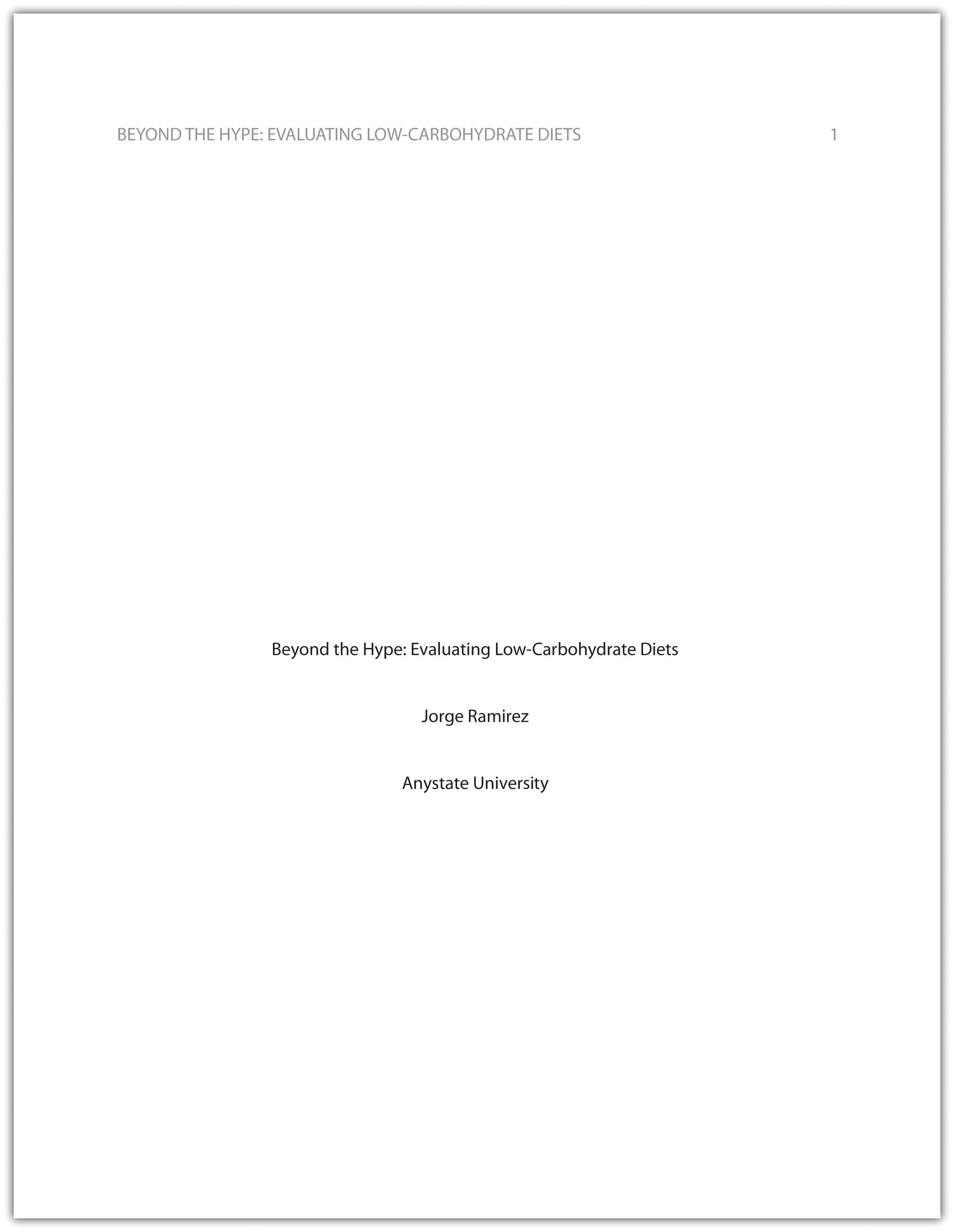
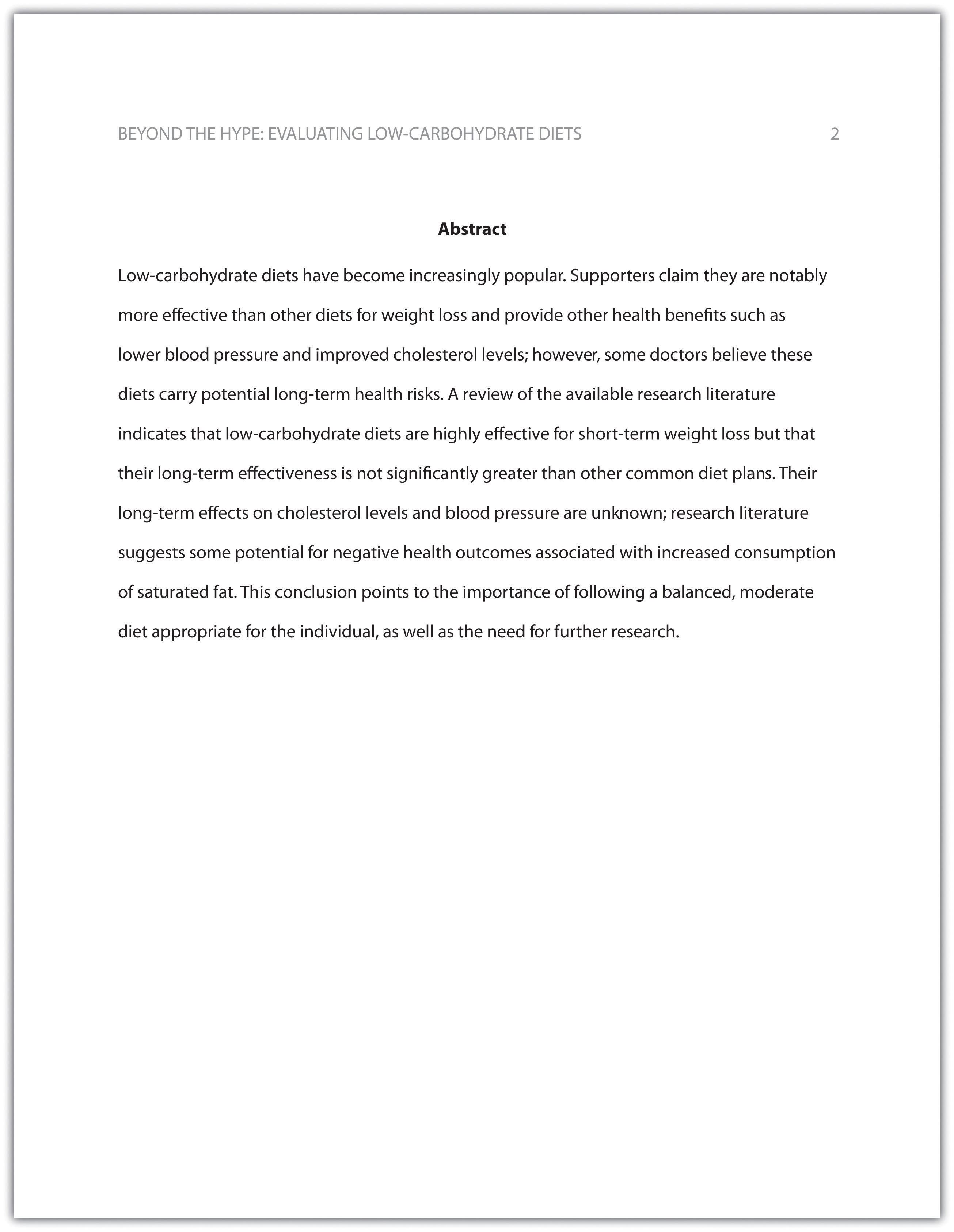
Headings
APA style uses section headings to organize information, making it easy for the reader to follow the writer’s train of thought and to know immediately what major topics are covered. Depending on the length and complexity of the paper, its major sections may also be divided into subsections, sub-subsections, and so on. These smaller sections, in turn, use different heading styles to indicate different levels of information. In essence, you are using headings to create a hierarchy of information.
The following heading styles used in APA formatting are listed in order of greatest to least importance:
- Section headings use centered, boldface type. Headings use title case, with important words in the heading capitalized.
- Subsection headings use left-aligned, boldface type. Headings use title case.
- The third level uses left-aligned, indented, boldface type. Headings use a capital letter only for the first word, and they end in a period.
- The fourth level follows the same style used for the previous level, but the headings are boldfaced and italicized.
- The fifth level follows the same style used for the previous level, but the headings are italicized and not boldfaced.
Visually, the hierarchy of information is organized as indicated in the table below.
Section Headings
| Level of Information | Text Example |
|---|---|
| Level 1 | Heart Disease |
| Level 2 | Lifestyle Factors That Reduce Heart Disease Risk |
| Level 3 | Exercising regularly. |
| Level 4 | Aerobic exercise. |
| Level 5 | Country line dancing. |
A college research paper may not use all the heading levels shown here, but you are likely to encounter them in academic journal articles that use APA style. For a brief paper, you may find that level 1 headings suffice. Longer or more complex papers may need level 2 headings or other lower-level headings to organize information clearly. Use your outline to craft your major section headings and determine whether any subtopics are substantial enough to require additional levels of headings.
Citation Guidelines
In-Text Citations
Throughout the body of your paper, include a citation whenever you quote or paraphrase material from your research sources. The purpose of citations is twofold: to give credit to others for their ideas and to allow your reader to follow up and learn more about the topic if desired. Your in-text citations provide basic information about your source; each source you cite will have a longer entry in the references section that provides more detailed information.
In-text citations must provide the name of the author or authors and the year the source was published. (When a given source does not list an individual author, you may provide the source title or the name of the organization that published the material instead.) When directly quoting a source, it is also required that you include the page number where the quote appears in your citation.
This information may be included within the sentence or in a parenthetical reference at the end of the sentence, as in these examples.
Epstein (2010) points out that “junk food cannot be considered addictive in the same way that we think of psychoactive drugs as addictive” (p. 137).
Here, the writer names the source author when introducing the quote and provides the publication date in parentheses after the author’s name. The page number appears in parentheses after the closing quotation marks and before the period that ends the sentence.
Addiction researchers caution that “junk food cannot be considered addictive in the same way that we think of psychoactive drugs as addictive” (Epstein, 2010, p. 137).
Here, the writer provides a parenthetical citation at the end of the sentence that includes the author’s name, the year of publication, and the page number separated by commas. Again, the parenthetical citation is placed after the closing quotation marks and before the period at the end of the sentence.
As noted in the book Junk Food, Junk Science (Epstein, 2010, p. 137), “junk food cannot be considered addictive in the same way that we think of psychoactive drugs as addictive.”
Here, the writer chose to mention the source title in the sentence (an optional piece of information to include) and followed the title with a parenthetical citation. Note that the parenthetical citation is placed before the comma that signals the end of the introductory phrase.
David Epstein’s book Junk Food, Junk Science (2010) pointed out that “junk food cannot be considered addictive in the same way that we think of psychoactive drugs as addictive” (p. 137).
Another variation is to introduce the author and the source title in your sentence and include the publication date and page number in parentheses within the sentence or at the end of the sentence. As long as you have included the essential information, you can choose the option that works best for that particular sentence and source.
References List
The brief citations included in the body of your paper correspond to the more detailed citations provided at the end of the paper in the references section. In-text citations provide basic information—the author’s name, the publication date, and the page number if necessary—while the references section provides more extensive bibliographical information. Again, this information allows your reader to follow up on the sources you cited and do additional reading about the topic if desired.
The specific format of entries in the list of references varies slightly for different source types, but the entries generally include the following information:
- The name(s) of the author(s) or institution that wrote the source
- The year of publication and, where applicable, the exact date of publication
- The full title of the source
- For books, the city of publication
- For articles or essays, the name of the periodical or book in which the article or essay appears
- For magazine and journal articles, the volume number, issue number, and pages where the article appears
- For sources on the web, the URL where the source is located
The references page is double spaced and lists entries in alphabetical order by the author’s last name. If an entry continues for more than one line, the second line and each subsequent line are indented five spaces.
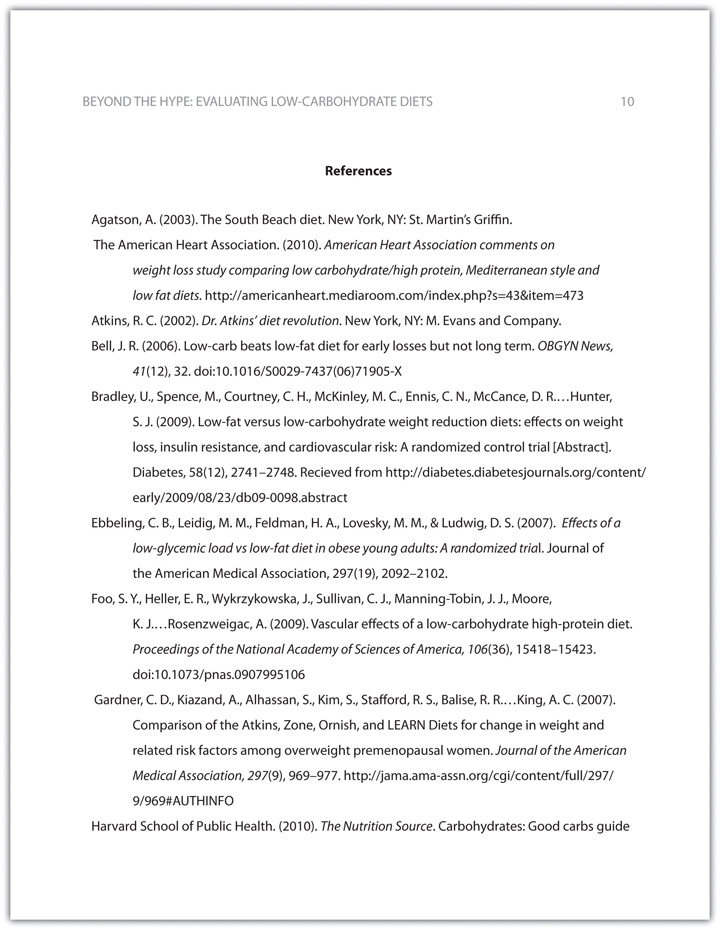
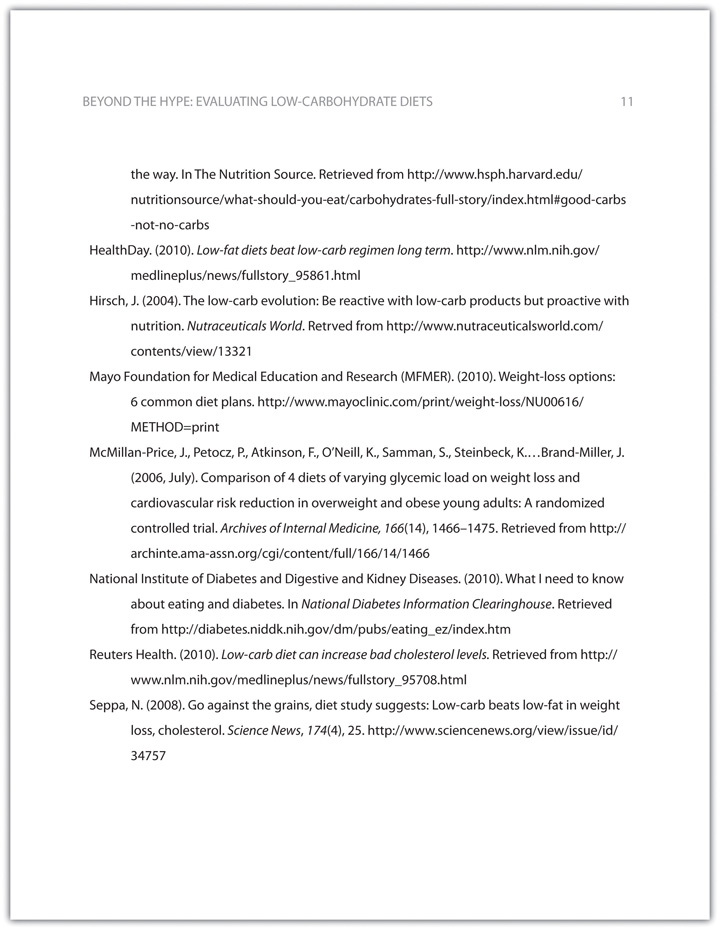
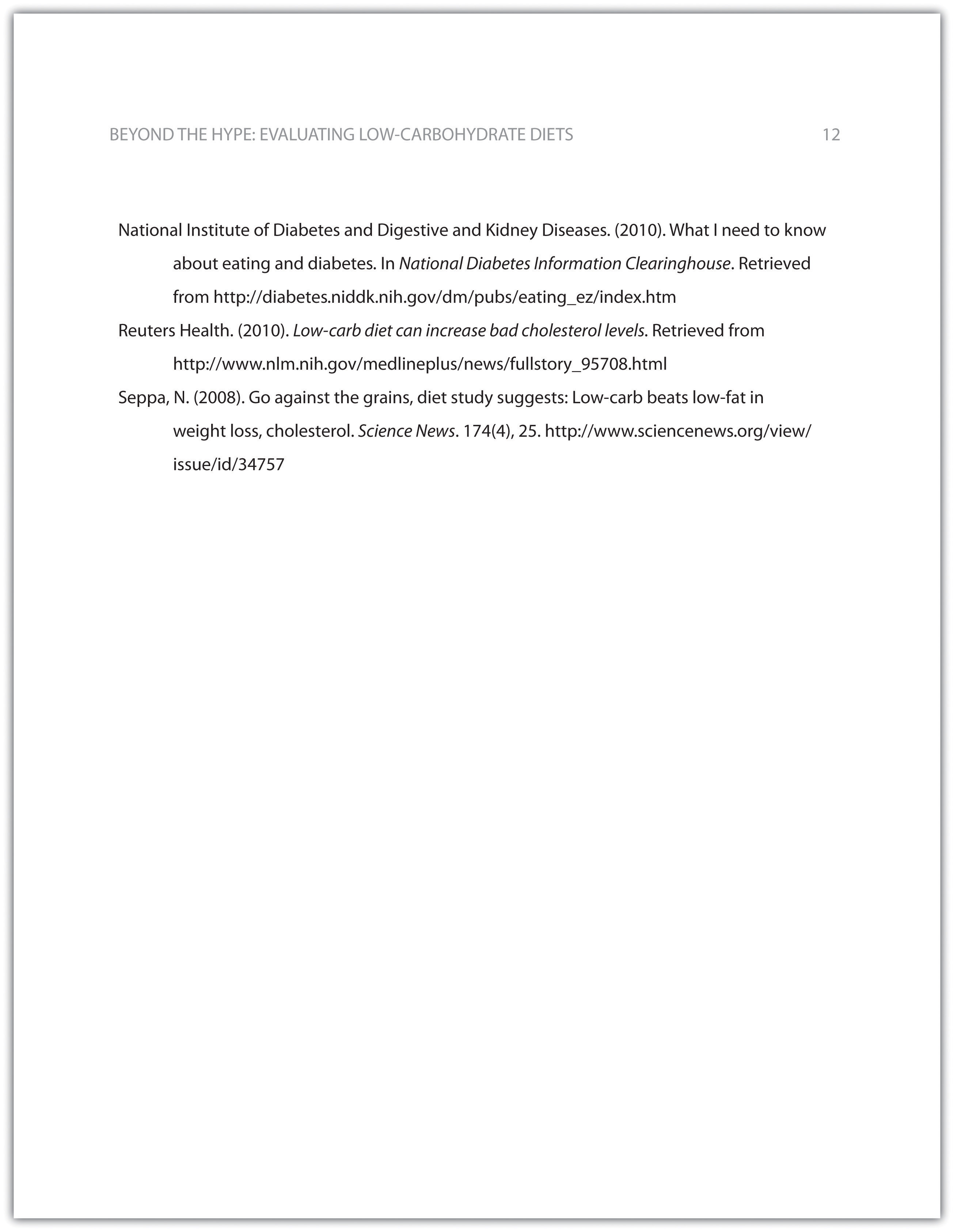
Tip
In APA style, book and article titles are formatted in sentence case, not title case. Sentence case means that only the first word is capitalized, along with any proper nouns.
Key Takeaways
- Following proper citation and formatting guidelines helps writers ensure that their work will be taken seriously, give proper credit to other authors for their work, and provide valuable information to readers.
- Working ahead and taking care to cite sources correctly the first time are ways writers can save time during the editing stage of writing a research paper.
- APA papers usually include an abstract that concisely summarizes the paper.
- APA papers use a specific headings structure to provide a clear hierarchy of information.
- In APA papers, in-text citations usually include the name(s) of the author(s) and the year of publication.
- In-text citations correspond to entries in the references section, which provide detailed bibliographical information about a source.
Citing and Referencing Techniques
This section covers the nitty-gritty details of in-text citations. You will learn how to format citations for different types of source materials, whether you are citing brief quotations, paraphrasing ideas, or quoting longer passages. You will also learn techniques you can use to introduce quoted and paraphrased material effectively. Keep this section handy as a reference to consult while writing the body of your paper.
Formatting Cited Material: The Basics
As noted in previous sections of this book, in-text citations usually provide the name of the author(s) and the year the source was published. For direct quotations, the page number must also be included. Use past-tense verbs when introducing a quote—“Smith found…” and not “Smith finds.…”
Formatting Brief Quotations
For brief quotations—fewer than forty words—use quotation marks to indicate where the quoted material begins and ends, and cite the name of the author(s), the year of publication, and the page number where the quotation appears in your source. Remember to include commas to separate elements within the parenthetical citation. Also, avoid redundancy. If you name the author(s) in your sentence, do not repeat the name(s) in your parenthetical citation. Review following the examples of different ways to cite direct quotations.
Chang (2008) emphasized that “engaging in weight-bearing exercise consistently is one of the single best things women can do to maintain good health” (p. 49).
The author’s name can be included in the body of the sentence or in the parenthetical citation. Note that when a parenthetical citation appears at the end of the sentence, it comes after the closing quotation marks and before the period. The elements within parentheses are separated by commas.
Weight Training for Women (Chang, 2008) claimed that “engaging in weight-bearing exercise consistently is one of the single best things women can do to maintain good health” (p. 49).
Weight Training for Women claimed that “engaging in weight-bearing exercise consistently is one of the single best things women can do to maintain good health” (Chang, 2008, p. 49).
Including the title of a source is optional.
In Chang’s 2008 text Weight Training for Women, she asserts, “Engaging in weight-bearing exercise is one of the single best things women can do to maintain good health” (p. 49).
The author’s name, the date, and the title may appear in the body of the text. Include the page number in the parenthetical citation. Also, notice the use of the verb asserts to introduce the direct quotation.
“Engaging in weight-bearing exercise,” Chang asserts, “is one of the single best things women can do to maintain good health” (2008, p. 49).
You may begin a sentence with the direct quotation and add the author’s name and a strong verb before continuing the quotation.
Formatting Paraphrased and Summarized Material
When you paraphrase or summarize ideas from a source, you follow the same guidelines previously provided, except that you are not required to provide the page number where the ideas are located. If you are summing up the main findings of a research article, simply providing the author’s name and publication year may suffice, but if you are paraphrasing a more specific idea, consider including the page number.
Read the following examples.
Chang (2008) pointed out that weight-bearing exercise has many potential benefits for women.
Here, the writer is summarizing a major idea that recurs throughout the source material. No page reference is needed.
Chang (2008) found that weight-bearing exercise could help women maintain or even increase bone density through middle age and beyond, reducing the likelihood that they will develop osteoporosis in later life (p. 86).
Although the writer is not directly quoting the source, this passage paraphrases a specific detail, so the writer chose to include the page number where the information is located.
Formatting Longer Quotations
When you quote a longer passage from a source—forty words or more—use a different format to set off the quoted material. Instead of using quotation marks, create a block quotation by starting the quotation on a new line and indented five spaces from the margin. Note that in this case, the parenthetical citation comes after the period that ends the sentence. Here is an example:
In recent years, many writers within the fitness industry have emphasized the ways in which women can benefit from weight-bearing exercise, such as weightlifting, karate, dancing, stair climbing, hiking, and jogging. Chang (2008) found that engaging in weight-bearing exercise regularly significantly reduces women’s risk of developing osteoporosis. Additionally, these exercises help women maintain muscle mass and overall strength, and many common forms of weight-bearing exercise, such as brisk walking or stair climbing, also provide noticeable cardiovascular benefits. (p. 93)
If you are quoting a passage that continues into a second paragraph, indent five spaces again in the first line of the second paragraph. Here is an example:
In recent years, many writers within the fitness industry have emphasized the ways in which women can benefit from weight-bearing exercise, such as weightlifting, karate, dancing, stair climbing, hiking, and jogging. Chang (2008) found that engaging in weight-bearing exercise regularly significantly reduces women’s risk of developing osteoporosis. Additionally, these exercises help women maintain muscle mass and overall strength, and many common forms of weight-bearing exercise, such as brisk walking or stair climbing, also provide noticeable cardiovascular benefits.
It is important to note that swimming cannot be considered a weight-bearing exercise, since the water supports and cushions the swimmer. That doesn’t mean swimming isn’t great exercise, but it should be considered one part of an integrated fitness program. (p. 93)
Tip
Be wary of quoting from sources at length. Remember, your ideas should drive the paper, and quotations should be used to support and enhance your points. Make sure any lengthy quotations that you include serve a clear purpose. Generally, no more than 10–15 percent of a paper should consist of quoted material.
Introducing Cited Material Effectively
Including an introductory phrase in your text, such as “Jackson wrote” or “Copeland found,” often helps you integrate source material smoothly. This citation technique also helps convey that you are actively engaged with your source material. Unfortunately, during the process of writing your research paper, it is easy to fall into a rut and use the same few dull verbs repeatedly, such as “Jones said,” “Smith stated,” and so on.
Punch up your writing by using strong verbs that help your reader understand how the source material presents ideas. There is a world of difference between an author who “suggests” and one who “claims,” one who “questions” and one who “criticizes.” You do not need to consult your thesaurus every time you cite a source, but do think about which verbs will accurately represent the ideas and make your writing more engaging. The following chart shows some possibilities.
| Strong Verbs for Introducing Cited Material | ||
|---|---|---|
| ask | suggest | question |
| explain | assert | claim |
| recommend | compare | contrast |
| propose | hypothesize | believe |
| insist | argue | find |
| determine | measure | assess |
| evaluate | conclude | study |
| warn | point out | sum up |
The material above provides an overview of the most frequently used elements of APA formatting. You will not be quizzed on the material below. What follows is more detailed material that you can use for reference as needed when writing a research paper with a wide variety of reference types.
Formatting In-Text Citations for Other Source Types
These sections discuss the correct format for various types of in-text citations. Read them through quickly to get a sense of what is covered, and then refer to them again as needed.
Print Sources
This section covers books, articles, and other print sources with one or more authors.
A Work by One Author
Always include the author’s name and year of publication. Include a page reference whenever you quote a source directly. (See also the guidelines presented earlier in this chapter about when to include a page reference for paraphrased material.)
Chang (2008) emphasized that “engaging in weight-bearing exercise consistently is one of the single best things women can do to maintain good health” (p. 49).
Chang (2008) pointed out that weight-bearing exercise has many potential benefits for women.
Two or More Works by the Same Author
At times, your research may include multiple works by the same author. If the works were published in different years, a standard in-text citation will serve to distinguish them. If you are citing multiple works by the same author published in the same year, include a lowercase letter immediately after the year. Rank the sources in the order they appear in your references section. The source listed first includes an a after the year, the source listed second includes a b, and so on.
Rodriguez (2009a) criticized the nutrition-supplement industry for making unsubstantiated and sometimes misleading claims about the benefits of taking supplements. Additionally, he warned that consumers frequently do not realize the potential harmful effects of some popular supplements (Rodriguez, 2009b).
Works by Authors with the Same Last Name
If you are citing works by different authors with the same last name, include each author’s initials in your citation, whether you mention them in the text or in parentheses. Do so even if the publication years are different.
J. S. Williams (2007) believes nutritional supplements can be a useful part of some diet and fitness regimens. C. D. Williams (2008), however, believes these supplements are overrated.
According to two leading researchers, the rate of childhood obesity exceeds the rate of adult obesity (K. Connelley, 2010; O. Connelley, 2010).
Studies from both A. Wright (2007) and C. A. Wright (2008) confirm the benefits of diet and exercise on weight loss.
A Work by Two Authors
When two authors are listed for a given work, include both authors’ names each time you cite the work. If you are citing their names in parentheses, use an ampersand (&) between them. (Use the word and, however, if the names appear in your sentence.)
As Garrison and Gould (2010) pointed out, “It is never too late to quit smoking. The health risks associated with this habit begin to decrease soon after a smoker quits” (p. 101).
As doctors continue to point out, “It is never too late to quit smoking. The health risks associated with this habit begin to decrease soon after a smoker quits” (Garrison & Gould, 2010, p. 101).
A Work by Three to Five Authors
If the work you are citing has three to five authors, list all the authors’ names the first time you cite the source. In subsequent citations, use the first author’s name followed by the abbreviation et al. (Et al. is short for et alia, the Latin phrase for “and others.”)
Henderson, Davidian, and Degler (2010) surveyed 350 smokers aged 18 to 30.
One survey, conducted among 350 smokers aged 18 to 30, included a detailed questionnaire about participants’ motivations for smoking (Henderson, Davidian, & Degler, 2010).
Note that these examples follow the same ampersand conventions as sources with two authors. Again, use the ampersand only when listing authors’ names in parentheses.
As Henderson et al. (2010) found, some young people, particularly young women, use smoking as a means of appetite suppression.
Disturbingly, some young women use smoking as a means of appetite suppression (Henderson et al., 2010).
Note how the phrase et al. is punctuated. No period comes after et, but al. gets a period because it is an abbreviation for a longer Latin word. In parenthetical references, include a comma after et al. but not before. Remember this rule by mentally translating the citation to English: “Henderson and others, 2010.”
A Work by Six or More Authors
If the work you are citing has six or more authors, list only the first author’s name, followed by et al., in your in-text citations. The other authors’ names will be listed in your references section.
Researchers have found that outreach work with young people has helped reduce tobacco use in some communities (Costello et al., 2007).
A Work Authored by an Organization
When citing a work that has no individual author(s) but is published by an organization, use the organization’s name in place of the author’s name. Lengthy organization names with well-known abbreviations can be abbreviated. In your first citation, use the full name, followed by the abbreviation in square brackets. Subsequent citations may use the abbreviation only.
It is possible for a patient to have a small stroke without even realizing it (American Heart Association [AHA], 2010).
Another cause for concern is that even if patients realize that they have had a stroke and need medical attention, they may not know which nearby facilities are best equipped to treat them (AHA, 2010).
A Work with No Listed Author
If no author is listed and the source cannot be attributed to an organization, use the title in place of the author’s name. You may use the full title in your sentence or use the first few words—enough to convey the key ideas—in a parenthetical reference. Follow standard conventions for using italics or quotations marks with titles:
- Use italics for titles of books or reports.
- Use quotation marks for titles of articles or chapters.
“Living With Diabetes: Managing Your Health” (2009) recommends regular exercise for patients with diabetes.
Regular exercise can benefit patients with diabetes (“Living with Diabetes,” 2009).
Rosenhan (1973) had mentally healthy study participants claim to be experiencing hallucinations so they would be admitted to psychiatric hospitals.
A Work Cited within Another Work
To cite a source that is referred to within another secondary source, name the first source in your sentence. Then, in parentheses, use the phrase as cited in and the name of the second source author.
Rosenhan’s study “On Being Sane in Insane Places” (as cited in Spitzer, 1975) found that psychiatrists diagnosed schizophrenia in people who claimed to be experiencing hallucinations and sought treatment—even though these patients were, in fact, imposters.
Two or More Works Cited in One Reference
At times, you may provide more than one citation in a parenthetical reference, such as when you are discussing related works or studies with similar results. List the citations in the same order they appear in your references section, and separate the citations with a semicolon.
Some researchers have found serious flaws in the way Rosenhan’s study was conducted (Dawes, 2001; Spitzer, 1975).
Both of these researchers authored works that support the point being made in this sentence, so it makes sense to include both in the same citation.
A Famous Text Published in Multiple Editions
In some cases, you may need to cite an extremely well-known work that has been repeatedly republished or translated. Many works of literature and sacred texts, as well as some classic nonfiction texts, fall into this category. For these works, the original date of publication may be unavailable. If so, include the year of publication or translation for your edition. Refer to specific parts or chapters if you need to cite a specific section. Discuss with your instructor whether he or she would like you to cite page numbers in this particular instance.
In New Introductory Lectures on Psycho-Analysis, Freud explains that the “manifest content” of a dream—what literally takes place—is separate from its “latent content,” or hidden meaning (trans. 1965, lecture XXIX).
Here, the student is citing a classic work of psychology, originally written in German and later translated to English. Since the book is a collection of Freud’s lectures, the student cites the lecture number rather than a page number.
An Introduction, Foreword, Preface, or Afterword
To cite an introduction, foreword, preface, or afterword, cite the author of the material and the year, following the same format used for other print materials.
Electronic Sources
Whenever possible, cite electronic sources as you would print sources, using the author, the date, and where appropriate, a page number. For some types of electronic sources—for instance, many online articles—this information is easily available. Other times, however, you will need to vary the format to reflect the differences in online media.
Online Sources without Page Numbers
If an online source has no page numbers but you want to refer to a specific portion of the source, try to locate other information you can use to direct your reader to the information cited. Some websites number paragraphs within published articles; if so, include the paragraph number in your citation. Precede the paragraph number with the abbreviation for the word paragraph and the number of the paragraph (e.g., para. 4).
As researchers have explained, “Incorporating fresh fruits and vegetables into one’s diet can be a challenge for residents of areas where there are few or no easily accessible supermarkets” (Smith & Jones, 2006, para. 4).
Even if a source does not have numbered paragraphs, it is likely to have headings that organize the content. In your citation, name the section where your cited information appears, followed by a paragraph number.
The American Lung Association (2010) noted, “After smoking, radon exposure is the second most common cause of lung cancer” (What Causes Lung Cancer? section, para. 2).
This student cited the appropriate section heading within the website and then counted to find the specific paragraph where the cited information was located.
If an online source has no listed author and no date, use the source title and the abbreviation n.d. in your parenthetical reference.
It has been suggested that electromagnetic radiation from cellular telephones may pose a risk for developing certain cancers (“Cell Phones and Cancer,” n.d.).
Personal Communication
For personal communications, such as interviews, letters, and e-mails, cite the name of the person involved, clarify that the material is from a personal communication, and provide the specific date the communication took place. Note that while in-text citations correspond to entries in the references section, personal communications are an exception to this rule. They are cited only in the body text of your paper.
J. H. Yardley, M.D., believes that available information on the relationship between cell phone use and cancer is inconclusive (personal communication, May 1, 2009).
Key Takeaways
- In APA papers, in-text citations include the name of the author(s) and the year of publication whenever possible.
- Page numbers are always included when citing quotations. It is optional to include page numbers when citing paraphrased material; however, this should be done when citing a specific portion of a work.
- When citing online sources, provide the same information used for print sources if it is available.
- When a source does not provide information that usually appears in a citation, in-text citations should provide readers with alternative information that would help them locate the source material. This may include the title of the source, section headings and paragraph numbers for websites, and so forth.
Creating a References Section
This section provides detailed information about how to create the references section of your paper. You will review basic formatting guidelines and learn how to format bibliographical entries for various types of sources.
Formatting the References Section: The Basics
At this stage in the writing process, you may already have begun setting up your references section. This section may consist of a single page for a brief research paper or may extend for many pages in professional journal articles. As you create this section of your paper, follow the guidelines provided here.
To set up your references section, use the insert page break feature of your word-processing program to begin a new page. Note that the header and margins will be the same as in the body of your paper, and pagination continues from the body of your paper. (In other words, if you set up the body of your paper correctly, the correct header and page number should appear automatically in your references section.) See additional guidelines below.
Formatting Reference Entries
Reference entries should include the following information:
- The name of the author(s)
- The year of publication and, where applicable, the exact date of publication
- The full title of the source
- For books, the city of publication
- For articles or essays, the name of the periodical or book in which the article or essay appears
- For magazine and journal articles, the volume number, issue number, and pages where the article appears
- For sources on the web, the URL where the source is located
See the following examples for how to format a book or journal article with a single author.
Sample Book Entry
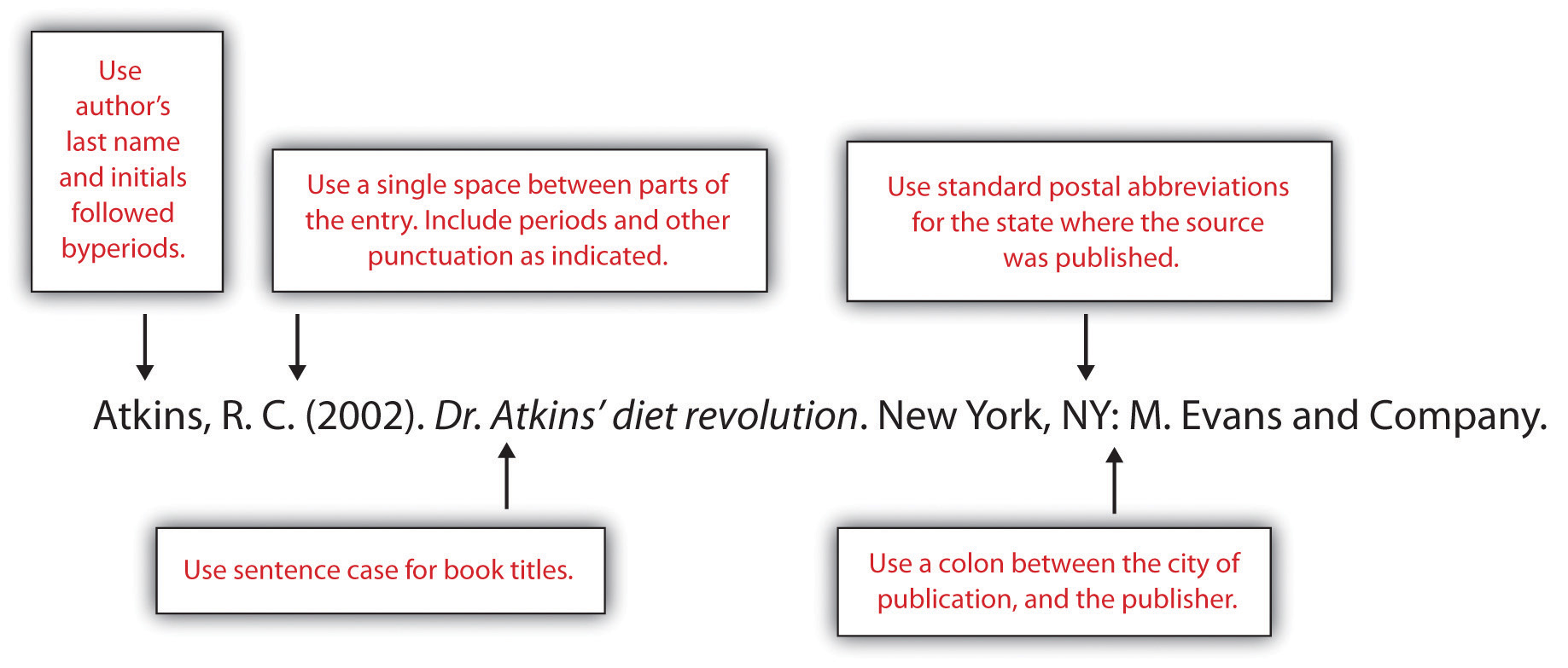
Sample Journal Article Entry
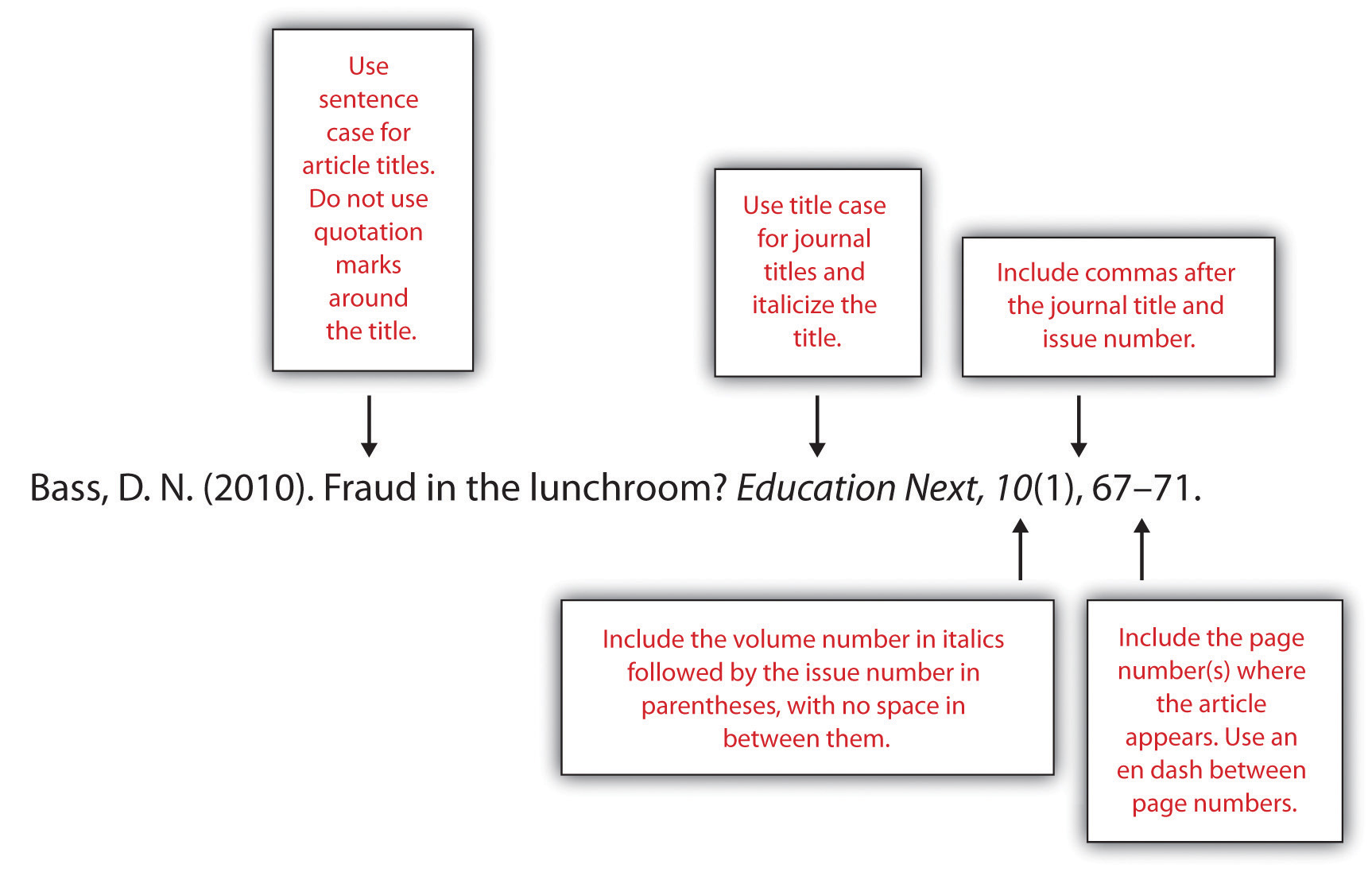
The following box provides general guidelines for formatting the reference page. For the remainder of this chapter, you will learn about how to format bibliographical entries for different source types, including multiauthor and electronic sources.
Formatting the References Section: APA General Guidelines
1. Include the heading References, centered at the top of the page. The heading should not be boldfaced, italicized, or underlined.
2. Use double-spaced type throughout the references section, as in the body of your paper.
3. Use hanging indentation for each entry. The first line should be flush with the left margin, while any lines that follow should be indented five spaces. Note that hanging indentation is the opposite of normal indenting rules for paragraphs.
4. List entries in alphabetical order by the author’s last name. For a work with multiple authors, use the last name of the first author listed.
5. List authors’ names using this format: Smith, J. C.
6. For a work with no individual author(s), use the name of the organization that published the work or, if this is unavailable, the title of the work in place of the author’s name.
7. For works with multiple authors, follow these guidelines:
- For works with up to seven authors, list the last name and initials for each author.
- For works with more than seven authors, list the first six names, followed by ellipses, and then the name of the last author listed.
- Use an ampersand before the name of the last author listed.
8. Use title case for journal titles. Capitalize all important words in the title.
9. Use sentence case for all other titles—books, articles, web pages, and other source titles. Capitalize the first word of the title. Do not capitalize any other words in the title except for the following:
- Proper nouns
- First word of a subtitle
- First word after a colon or dash
10. Use italics for book and journal titles. Do not use italics, underlining, or quotation marks for titles of shorter works, such as articles.
Formatting Reference Entries for Different Source Types
As is the case for in-text citations, formatting reference entries becomes more complicated when you are citing a source with multiple authors, citing various types of online media, or citing sources for which you must provide additional information beyond the basics listed in the general guidelines. The following guidelines show how to format reference entries for these different situations.
Print Sources: Books
For book-length sources and shorter works that appear in a book, follow the guidelines that best describes your source.
A Book by Two or More Authors
List the authors’ names in the order they appear on the book’s title page. Use an ampersand before the last author’s name.
Campbell, D. T., & Stanley, J. C. (1963). Experimental and quasi-experimental designs for research. Boston, MA: Houghton Mifflin.
An Edited Book with No Author
List the editor or editors’ names in place of the author’s name, followed by Ed. or Eds. in parentheses.
Myers, C., & Reamer, D. (Eds.). (2009). 2009 nutrition index. San Francisco, CA: HealthSource, Inc.
An Edited Book with an Author
List the author’s name first, followed by the title and the editor or editors. Note that when the editor is listed after the title, you list the initials before the last name.

A Translated Book
Include the translator’s name after the title, and at the end of the citation, list the date the original work was published. Note that for the translator’s name, you list the initials before the last name.
Freud, S. (1965). New introductory lectures on psycho-analysis (J. Strachey, Trans.). New York, NY: W. W. Norton. (Original work published 1933).
A Book Published in Multiple Editions
If you are using any edition other than the first edition, include the edition number in parentheses after the title.

A Chapter in an Edited Book
List the name of the author(s) who wrote the chapter, followed by the chapter title. Then list the names of the book editor(s) and the title of the book, followed by the page numbers for the chapter and the usual information about the book’s publisher.

A Work That Appears in an Anthology
Follow the same process you would use to cite a book chapter, substituting the article or essay title for the chapter title.

An Article in a Reference Book
List the author’s name if available; if no author is listed, provide the title of the entry where the author’s name would normally be listed. If the book lists the name of the editor(s), include it in your citation. Indicate the volume number (if applicable) and page numbers in parentheses after the article title.

Two or More Books by the Same Author
List the entries in order of their publication year, beginning with the work published first.
Swedan, N. (2001). Women’s sports medicine and rehabilitation. Gaithersburg, MD: Aspen Publishers.
Swedan, N. (2003). The active woman’s health and fitness handbook. New York, NY: Perigee.
If two books have multiple authors, and the first author is the same but the others are different, alphabetize by the second author’s last name (or the third or fourth, if necessary).
Carroll, D., & Aaronson, F. (2008). Managing type II diabetes. Chicago, IL: Southwick Press.
Carroll, D., & Zuckerman, N. (2008). Gestational diabetes. Chicago, IL: Southwick Press.
Books by Different Authors with the Same Last Name
Alphabetize entries by the authors’ first initial.

A Book Authored by an Organization
Treat the organization name as you would an author’s name. For the purposes of alphabetizing, ignore words like The in the organization’s name. (That is, a book published by the American Heart Association would be listed with other entries whose authors’ names begin with A.)
American Psychiatric Association. (1994). Diagnostic and statistical manual of mental disorders DSM-IV (4th ed.). Arlington, VA: American Psychiatric Publishing.
A Book-Length Report
Format technical and research reports as you would format other book-length sources. If the organization that issued the report assigned it a number, include the number in parentheses after the title. (See also the guidelines provided for citing works produced by government agencies.)
Jameson, R., & Dewey, J. (2009). Preliminary findings from an evaluation of the president’s physical fitness program in Pleasantville school district. Pleasantville, WA: Pleasantville Board of Education.
A Book Authored by a Government Agency
Treat these as you would a book published by a nongovernment organization, but be aware that these works may have an identification number listed. If so, include it in parentheses after the publication year.
U.S. Census Bureau. (2002). The decennial censuses from 1790 to 2000 (Publication No. POL/02-MA). Washington, DC: US Government Printing Offices.
Print Sources: Periodicals
An Article in a Scholarly Journal
Include the following information:
- Author or authors’ names
- Publication year
- Article title (in sentence case, without quotation marks or italics)
- Journal title (in title case and in italics)
- Volume number (in italics)
- Issue number (in parentheses)
- Page number(s) where the article appears
DeMarco, R. F. (2010). Palliative care and African American women living with HIV. Journal of Nursing Education, 49(5), 1–4.
An Article in a Journal Paginated by Volume
In these types of journals, page numbers for one volume continue across all the issues in that volume. For instance, the winter issue may begin with page 1, and in the spring issue that follows, the page numbers pick up where the previous issue left off. (If you have ever wondered why a print journal did not begin on page 1, or wondered why the page numbers of a journal extend into four digits, this is why.) Omit the issue number from your reference entry.
Wagner, J. (2009). Rethinking school lunches: A review of recent literature. American School Nurses’ Journal, 47, 1123–1127.
An Abstract of a Scholarly Article
At times you may need to cite an abstract—the summary that appears at the beginning—of a published article. If you are citing the abstract only, and it was published separately from the article, provide the following information:
- Publication information for the article
- Information about where the abstract was published (for instance, another journal or a collection of abstracts)

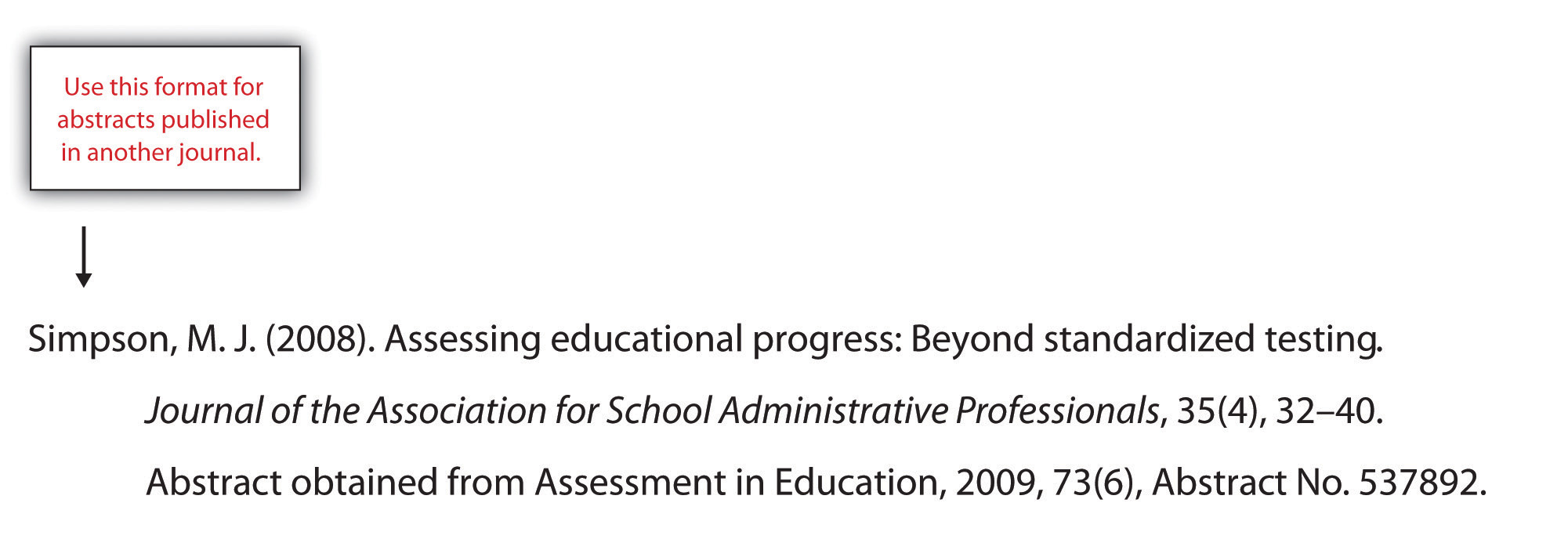
A Journal Article with Two to Seven Authors
List all the authors’ names in the order they appear in the article. Use an ampersand before the last name listed.
Barker, E. T., & Bornstein, M. H. (2010). Global self-esteem, appearance satisfaction, and self-reported dieting in early adolescence. Journal of Early Adolescence, 30(2), 205–224.
Tremblay, M. S., Shields, M., Laviolette, M., Craig, C. L., Janssen, I., & Gorber, S. C. (2010). Fitness of Canadian children and youth: Results from the 2007–2009 Canadian Health Measures Survey. Health Reports, 21(1), 7–20.
A Journal Article with More Than Seven Authors
List the first six authors’ names, followed by a comma, an ellipsis, and the name of the last author listed. The article in the following example has sixteen listed authors; the reference entry lists the first six authors and the sixteenth, omitting the seventh through the fifteenth.

A Magazine Article
After the publication year, list the issue date. Otherwise, treat these as you would journal articles. List the volume and issue number if both are available.

A Newspaper Article
Treat these as you would magazine and journal articles, with one important difference: precede the page number(s) with the abbreviation p. (for a single-page article) or pp. (for a multipage article). For articles whose pagination is not continuous, list all the pages included in the article. For example, an article that begins on page A1 and continues on pages A4 would have the page reference A1, A4. An article that begins on page A1 and continues on pages A4 and A5 would have the page reference A1, A4–A5.

A Letter to the Editor
After the title, indicate in brackets that the work is a letter to the editor.
Jones, J. (2009, January 31). Food police in our schools [Letter to the editor]. Rockwood Gazette, p. A8.
A Review
After the title, indicate in brackets that the work is a review and state the name of the work being reviewed. (Note that even if the title of the review is the same as the title of the book being reviewed, as in the following example, you should treat it as an article title. Do not italicize it.)

Electronic Sources
Citing Articles from Online Periodicals: URLs and Digital Object Identifiers (DOIs)
Whenever you cite online sources, it is important to provide the most up-to-date information available to help readers locate the source. In some cases, this means providing an article’s URL, or web address. (The letters URL stand for uniform resource locator.) Always provide the most complete URL possible. Provide a link to the specific article used, rather than a link to the publication’s homepage.
As you know, web addresses are not always stable. If a website is updated or reorganized, the article you accessed in April may move to a different location in May. The URL you provided may become a dead link. For this reason, many online periodicals, especially scholarly publications, now rely on DOIs rather than URLs to keep track of articles.
A DOI is a Digital Object Identifier—an identification code provided for some online documents, typically articles in scholarly journals. Like a URL, its purpose is to help readers locate an article. However, a DOI is more stable than a URL, so it makes sense to include it in your reference entry when possible. Follow these guidelines:
- If you are citing an online article with a DOI, list the DOI at the end of the reference entry.
- If the article appears in print as well as online, you do not need to provide the URL. However, include the words Electronic version after the title in brackets.
- In other respects, treat the article as you would a print article. Include the volume number and issue number if available. (Note, however, that these may not be available for some online periodicals).
An Article from an Online Periodical with a DOI
List the DOI if one is provided. There is no need to include the URL if you have listed the DOI.
Bell, J. R. (2006). Low-carb beats low-fat diet for early losses but not long term. OBGYN News, 41(12), 32. doi:10.1016/S0029-7437(06)71905-X
An Article from an Online Periodical with No DOI
List the URL. Include the volume and issue number for the periodical if this information is available. (For some online periodicals, it may not be.)

Note that if the article appears in a print version of the publication, you do not need to list the URL, but do indicate that you accessed the electronic version.
Robbins, K. (2010, March/April). Nature’s bounty: A heady feast [Electronic version]. Psychology Today, 43(2), 58.
A Newspaper Article
Provide the URL of the article.
McNeil, D. G. (2010, May 3). Maternal health: A new study challenges benefits of vitamin A for women and babies. The New York Times. Retrieved from http://www.nytimes.com/2010/05/04/health/04glob.html?ref=health
An Article Accessed through a Database
Cite these articles as you would normally cite a print article. Provide database information only if the article is difficult to locate.
An Abstract of an Article
Format these as you would an article citation, but add the word Abstract in brackets after the title.
Bradley, U., Spence, M., Courtney, C. H., McKinley, M. C., Ennis, C. N., McCance, D. R.…Hunter, S. J. (2009). Low-fat versus low-carbohydrate weight reduction diets: Effects on weight loss, insulin resistance, and cardiovascular risk: A randomized control trial [Abstract]. Diabetes, 58(12), 2741–2748. http://diabetes.diabetesjournals.org/content/early/2009/08/23/db00098.abstract
A Nonperiodical Web Document
The ways you cite different nonperiodical web documents may vary slightly from source to source, depending on the information that is available. In your citation, include as much of the following information as you can:
- Name of the author(s), whether an individual or organization
- Date of publication (Use n.d. if no date is available.)
- Title of the document
- Address where you retrieved the document
If the document consists of more than one web page within the site, link to the homepage or the entry page for the document.
American Heart Association. (2010). Heart attack, stroke, and cardiac arrest warning signs. Retrieved from http://www.americanheart.org/presenter.jhtml?identifier=3053
An Entry from an Online Encyclopedia or Dictionary
Because these sources often do not include authors’ names, you may list the title of the entry at the beginning of the citation. Provide the URL for the specific entry.
Addiction. (n.d.) In Merriam-Webster’s online dictionary. Retrieved from http://www.merriam-webster.com/dictionary/addiction
Data Sets
If you cite raw data compiled by an organization, such as statistical data, provide the URL where you retrieved the information. Provide the name of the organization that sponsors the site.
US Food and Drug Administration. (2009). Nationwide evaluation of X-ray trends: NEXT surveys performed [Data file]. Retrieved from http://www.fda.gov/Radiation-EmittingProducts/RadiationSafety/NationwideEvaluationofX- RayTrendsNEXT/ucm116508.htm
Graphic Data
When citing graphic data—such as maps, pie charts, bar graphs, and so on—include the name of the organization that compiled the information, along with the publication date. Briefly describe the contents in brackets. Provide the URL where you retrieved the information. (If the graphic is associated with a specific project or document, list it after your bracketed description of the contents.)
US Food and Drug Administration. (2009). [Pie charts showing the percentage breakdown of the FDA’s budget for fiscal year 2005]. 2005 FDA budget summary. Retrieved from mhttp://www.fda.gov/AboutFDA/ReportsManualsForms/Reports/BudgetReports/2005FDABudgetSummary/ucm117231.htm
An Online Interview (Audio File or Transcript)
List the interviewer, interviewee, and date. After the title, include bracketed text describing the interview as an “Interview transcript” or “Interview audio file,” depending on the format of the interview you accessed. List the name of the website and the URL where you retrieved the information. Use the following format.
Davies, D. (Interviewer), & Pollan, M. (Interviewee). (2008). Michael Pollan offers president food for thought [Interview transcript]. Retrieved from National Public Radio website: http://www.npr.org/templates/transcript/transcript.php?storyId=100755362
An Electronic Book
Electronic books may include books available as text files online or audiobooks. If an electronic book is easily available in print, cite it as you would a print source. If it is unavailable in print (or extremely difficult to find), use the format in the example. (Use the words Available from in your citation if the book must be purchased or is not available directly.)
Chisholm, L. (n.d.). Celtic tales. Retrieved from http://www.childrenslibrary.org/icdl/BookReader?bookid= chicelt_00150014&twoPage=false&route=text&size=0&fullscreen=false&pnum1=1&lang= English&ilang=English
A Chapter from an Online Book or a Chapter or Section of a Web Document
These are treated similarly to their print counterparts with the addition of retrieval information. Include the chapter or section number in parentheses after the book title.
Hart, A. M. (1895). Restoratives—Coffee, cocoa, chocolate. In Diet in sickness and in health (VI). Retrieved from http://www.archive.org/details/dietinsicknessin00hartrich
A Dissertation or Thesis from a Database
Provide the author, date of publication, title, and retrieval information. If the work is numbered within the database, include the number in parentheses at the end of the citation.

Computer Software
For commonly used office software and programming languages, it is not necessary to provide a citation. Cite software only when you are using a specialized program, such as the nutrition tracking software in the following example. If you download software from a website, provide the version and the year if available.
Internet Brands, Inc. (2009). FitDay PC (Version 2) [Software]. Available from http://www.fitday.com/Pc/PcHome.html?gcid=14
A Post on a Blog or Video Blog
Citation guidelines for these sources are similar to those used for discussion forum postings. Briefly describe the type of source in brackets after the title.
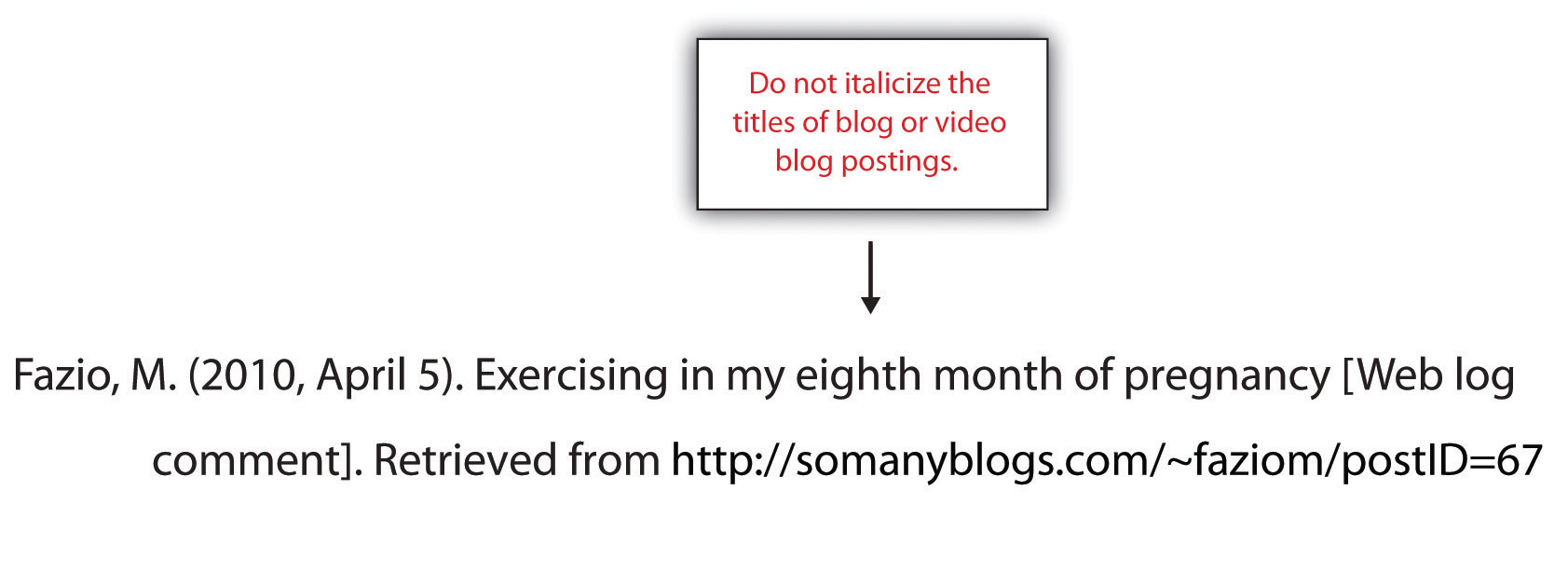
A Television or Radio Broadcast
Include the name of the producer or executive producer; the date, title, and type of broadcast; and the associated company and location.
West, Ty. (Executive producer). (2009, September 24). PBS special report: Health care reform [Television broadcast]. New York, NY, and Washington, DC: Public Broadcasting Service.
A Television or Radio Series or Episode
Include the producer and the type of series if you are citing an entire television or radio series.
Couture, D., Nabors, S., Pinkard, S., Robertson, N., & Smith, J. (Producers). (1979). The Diane Rehm show [Radio series]. Washington, DC: National Public Radio.
To cite a specific episode of a radio or television series, list the name of the writer or writers (if available), the date the episode aired, its title, and the type of series, along with general information about the series.
Bernanke, J., & Wade, C. (2010, January 10). Hummingbirds: Magic in the air [Television series episode]. In F. Kaufman (Executive producer), Nature. New York, NY: WNET.
A Motion Picture
Name the director or producer (or both), year of release, title, country of origin, and studio.
Spurlock, M. (Director/producer), Morley, J. (Executive producer), & Winters. H. M. (Executive producer). (2004). Super size me. United States: Kathbur Pictures in association with Studio on Hudson.
A Recording
Name the primary contributors and list their role. Include the recording medium in brackets after the title. Then list the location and the label.
Smith, L. W. (Speaker). (1999). Meditation and relaxation [CD]. New York, NY: Earth, Wind, & Sky Productions.
Székely, I. (Pianist), Budapest Symphony Orchestra (Performers), & Németh, G. (Conductor). (1988). Chopin piano concertos no. 1 and 2 [CD]. Hong Kong: Naxos.
A Podcast
Provide as much information as possible about the writer, director, and producer; the date the podcast aired; its title; any organization or series with which it is associated; and where you retrieved the podcast.
Kelsey, A. R. (Writer), Garcia, J. (Director), & Kim, S. C. (Producer). (2010, May 7). Lies food labels tell us. Savvy consumer podcasts [Audio podcast]. Retrieved from http://www.savvyconsumer.org/podcasts/050710
Key Takeaways
In APA papers, entries in the references section include as much of the following information as possible:
- Print sources. Author(s), date of publication, title, publisher, page numbers (for shorter works), editors (if applicable), and periodical title (if applicable).
- Online sources (text-based). Author(s), date of publication, title, publisher or sponsoring organization, and DOI or URL (if applicable).
- Electronic sources (non-text-based). Provide details about the creator(s) of the work, title, associated company or series, and date the work was produced or broadcast. The specific details provided will vary depending on the medium and the information that is available.
- Electronic sources (text-based). If an electronic source is also widely available in print form, it is sometimes unnecessary to provide details about how to access the electronic version. Check the guidelines for the specific source type.
